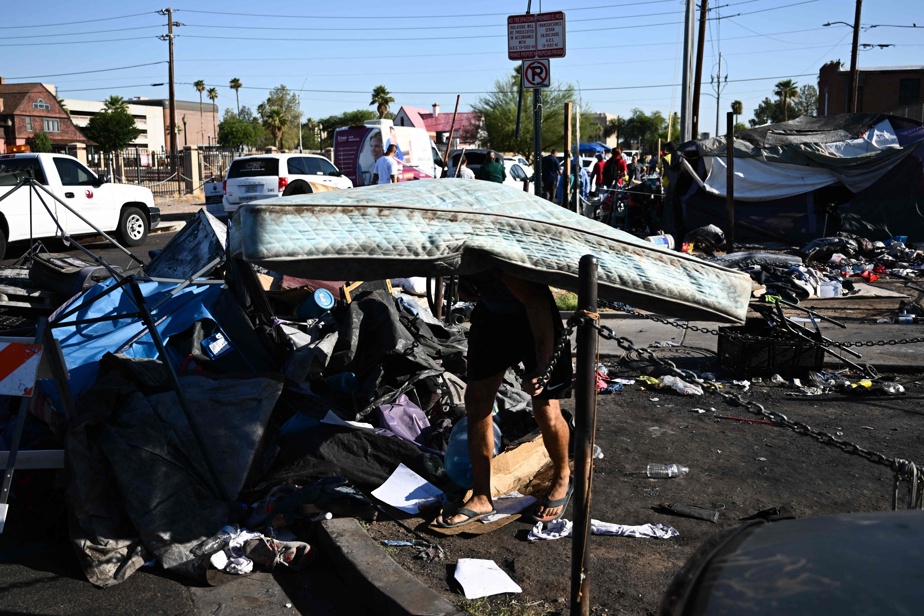(Phoenix) Under the meager tarps that serve as shelter on the sidewalk, Dana Page drinks as much water as she can in the furnace of Phoenix, Arizona. At more than 47°C, the heat is merciless: it has just killed one of its companions in misfortune in recent days.
In “the Zone”, a vast camp which brings together hundreds of homeless people just next to the city center of the metropolis, the fifty-year-old was nicknamed “Joker”. After seeing the emergency services give him a heart massage, Mr.me Page has heard the word “dehydration”.
“He died a few centimeters from the water,” she sighs, surrounded by her bottles and a large container where she melts ice. “He should have been smarter. »
Built in the middle of the desert, Phoenix is used to brutal summers. But the capital of Arizona and its 1.6 million inhabitants are currently hit by an unprecedented heat wave, resembling a marathon.
The heat on Wednesday smashed a longevity record for the city, briskly exceeding 110° Fahrenheit (43°C) for a 20e consecutive day. This suffocating series, which must continue for several more days, raises fears of the worst in one of the American cities hardest hit by homelessness.
For homeless people locked outside, the risk of heat stroke is ever-present. At 49, Dana Page knows something about it: she has suffered three in the past five years.
“It was as if someone had thrown me on Earth for the first time,” she told AFP, listing the symptoms that surprised her: memory lapses, disorientation, half of the paralyzed face. “He’s a sneaky killer. That’s how they die, we don’t realize it. »
No respite
The extreme heat of this month of July offers no respite. The monsoon, usually a source of brief rainy spells, is absent. And the nights are incandescent: walking in the darkness of Phoenix feels like walking the depths of an oven.
“If this continues, we will see more heat-related deaths,” fears Amy Schwabenlender, director of the Human Services Campus, a huge site that brings together accommodation centers and medico-social services run by 16 associations.
By 2022, Maricopa County, which encompasses Phoenix and its suburbs, had already seen a 25% increase in heat-related deaths, with 425 fatalities. A tragedy largely fueled by the explosion in the number of homeless people (+ 23.4%) in Arizona since the 2020 pandemic.
In the State of the Grand Canyon, the cruel lack of social housing propels the poorest to the rank of the first victims of global warming, which aggravates the frequency of extreme weather events.
To deal with the emergency, the Human Services Campus is running at full speed. Its associations send marauders at dawn to distribute 2,000 bottles of water each day, sunscreen and hats to shelter from the deadly sun.
Like about sixty other places in town, the site also serves as a “cooling point”, where the homeless can find shade, misters, and a large air-conditioned dining hall that shows films.
Outside, the slightest mistake can have disastrous consequences: the boiling pavement becomes a major enemy.
“People lying on the sidewalk, even on a blanket, can burn their arms, legs,” says Ms.me Schwabenlender. “People are often without socks or shoes and can burn their feet. »
number one killer
Just a few days ago, José Itafranco narrowly escaped such a mishap. After using methamphetamine, this former house painter collapsed on the sidewalk.
Fortunately for him, his wife Alvira was able to place his head on her knees while the firefighters examined him.
“Methamphetamine […] it gives you the impression of being the incredible Hulk, of being untouchable, ”confides the thirty-year-old, still sheepish. “But what’s really happening is you’re getting dehydrated. »
After 11 years in Arizona, he finds this heat wave “really brutal”.
Pernicious and invisible, heat remains the deadliest weather phenomenon in the United States. However, the federal government does not allocate emergency aid to deal with it, unlike other natural disasters – floods, forest fires or hurricanes.
A situation that Mme Schwabenlender would like to see change.
“We are the United States of America, we should not have more than 400 people dying (in the county) as a result of the heat”, estimates the association manager. “We have enough resources to help everyone, we just have to figure out how to pool them. »
